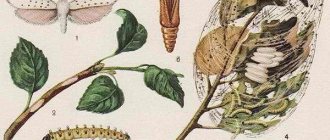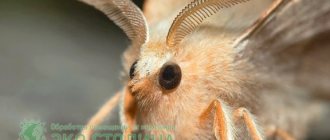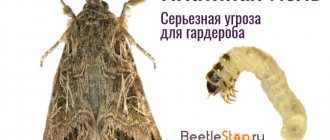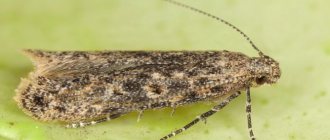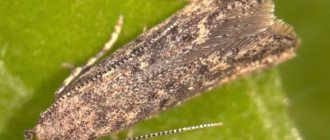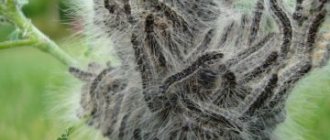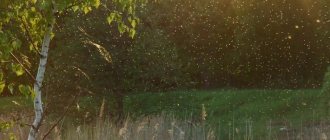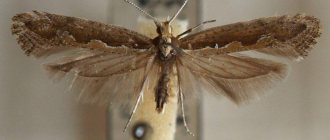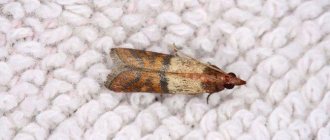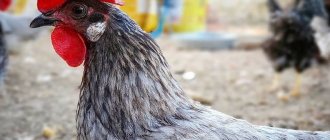Potato moth can destroy up to 80% of the crop. In the summer season, when insects eat the vegetative part of the plant, the activity of the pest is not limited. In autumn, the larvae infect tubers sent for storage, in each of which, if heavily infested, up to 10 individuals of different ages and sizes can be found.
Potato moth is a dangerous pest that damages potato tubers.
General information about potato moth
The scientific name of this insect is fluorimea. This pest is considered more dangerous than the Colorado potato beetle. Human economic activity has contributed to the spread of potato moth. It is considered heat-loving, so severe frosts prevent its reproduction in nature.
Geographical distribution
The historical homeland of fluorimea is certain areas of South and Central America, where plants belonging to the Solanaceae family are found in nature. For a long time it was found only in this region. Small outbreaks of potato infection with it were observed in Italy, Spain, Greece, as well as in Asian countries where seed material was imported from America. This is due to the climatic characteristics of these regions.
Only in the 80s. last century, the pest was first identified in the Crimea.
It is believed that the larvae were introduced along with tobacco and tomatoes. In the south of Russia, incl. in the Krasnodar region, the insect was discovered later. In addition, potato moth outside the boundaries of its natural range was identified in:
- China;
- Belarus;
- Ukraine;
- Kazakhstan;
- Australia;
- New Zealand;
- Kenya;
- Egypt;
- Iran;
- Tunisia;
- Algeria;
- Syria;
- Bolivia;
- Peru, etc.
Distribution area of the potato moth.
The slow spread of fluorimea is largely due to global warming. Now this insect can survive in regions where, until recently, severe winter frosts led to the death of adults and larvae remaining in the soil. The spread of the pest was also facilitated by improved storage conditions for tubers. The larvae are able to maintain vital activity if the temperature in the cellar does not drop below +10°C. They are often found on the walls of wooden boxes in the form of pupae.
How dangerous is the pest?
Potato moth caterpillars primarily choose potatoes, tomatoes, peppers, eggplants, and some other crops belonging to the nightshade family as their habitat. In winter, these insects multiply, and in the spring they penetrate into the soil along with planting materials.
It happens that fluorimea quietly spends the whole winter in the open ground under a layer of fallen leaves. In addition, the insect moves from year to year into storage for the harvest. The reproduction of potato moth occurs not only on land where plants grow, but also in closed warehouses for storing crops. Measures to combat it must be comprehensive - only then will they ensure high efficiency.
Potato moth larvae cause damage to agricultural crops:
- destroy the stems and leaves of potatoes, as a result the plants lose their strength;
- damage potato tubers, which leads to a significant deterioration in crop characteristics;
- reduce the volume of seed and its quality;
- interfere with the normal natural development of young tomato and pepper bushes.
In the spring, the larvae of potato moths are engaged in the destruction of young, immature seedlings, so it is necessary to fight them here too. And later, when tubers and fruits begin to develop on plant bushes, a huge number of caterpillars appear. Even one larva can completely spoil the fruit.
The greatest danger is posed by five to ten caterpillars sitting on one tuber - they eat away almost all of its core.
This pest can penetrate inside potato tubers through existing small damage and eyes, and into eggplants and tomatoes through their stalks. If the total amount of damage is up to 70-80%, the ability to preserve is significantly reduced, and such a crop requires mandatory processing.
Link on topic
External description of the insect
An adult butterfly has a nondescript appearance. The upper pair of wings is brownish-brown, and the lower pair is grayish. A large number of dark spots and streaks make the pest invisible. The edges of the wings are fringed with a fringe of fine hairs. The body is short and narrow, the insect has 3 pairs of limbs. There are long antennae on the head.
The oral apparatus of an adult is underdeveloped. The pupa has a dense, chitinous covering of brown color. The larva is white with a pale pink back and head. The adult caterpillar is covered with greenish-gray, stiff bristles.
Dimensions
The body of the butterfly is 7 mm in size, and the wingspan reaches 13 mm. The larvae grow up to 2 cm. The length of the pupa is about 1.5 cm, and the eggs are 0.8 mm.
Appearance of potato moth.
Features of development
The life activity of the pest depends on the temperature regime. On average, under favorable conditions, the development of a moth from egg to adult takes about 4 weeks.
Life cycle
The life cycle of the potato moth includes 4 stages: egg, larva, cocoon and butterfly. Females can lay eggs at +8…+25°C.
After mating, the female lives on average about 2-5 days. In rare cases, when she has difficulty finding a partner, the individual can live up to 2 weeks. Potato moths can multiply both in fields and in potato storage areas. At temperatures below -4°C, the pupae also die.
Story
Just some 150 years ago, potato moth was unheard of in our country. This scourge came to our country not so long ago, and the population of the southern regions was the first to become acquainted with it. The natural environment for the potato moth is Africa. It was here that hordes of pests walked in ancient times. Today, the moth has spread throughout the entire planet, where the average annual temperature does not drop below 10 degrees - only in such a climate can the moth reproduce.
It is very important to find out in time what potato moth is and how to fight it.
Lifestyle
The life of the pest is associated with plants belonging to the Solanaceae family. Adult moths have a good sense of smell. She can even smell those tubers that were packed in canvas bags.
Adults cannot eat fully and live off the nutrients accumulated in the larval form.
At the same time, the insect is able to travel up to 3 km in search of plantings necessary for feeding the young.
What do potato moths eat?
Fluorimea feeds not only on potato tubers and tops. The diet of this pest includes the following crops:
- tomatoes;
- petunias;
- pepper;
- physalis;
- tobacco;
- eggplant.
In addition, some weeds may suffer from this insect, incl. Datura, black henbane and wolfberry.
Wintering of the pest
In warm regions, formed potato moth pupae overwinter under the remains of tops. In the northern regions, immediately after the tops dry out, the caterpillars move into the ground and infect the tubers. Subsequently, they pupate and remain in the soil at a depth of up to 20 cm. The emergence of adult individuals in this case occurs in May.
If the caterpillars are not yet fully formed, they remain in the tubers. They are dug up along with potatoes and stored in cellars. In larvae kept in a cool room, development proceeds more slowly. They reach adulthood only in spring.
Origin
The second name for potato moth is fluorimea.
In South America, fluoromea, together with the Colorado potato beetle, has been destroying fields since time immemorial. It moved to the south of Europe at the beginning of the last century in potatoes imported from the New World. And for several years now, despite quarantine measures, the presence of moths has been registered in Russia. Its main habitat is the southern regions, since for normal fluoride development an average annual temperature of at least +10 °C is needed. For example, in the mild climate of Kuban, up to eight generations of the pest can grow over the summer.
Unfortunately, the potato moth begins to gradually adapt to lower temperatures and is spreading in the temperate climate of central Russia.
Reproduction nuances
The female makes up to 4 clutches in summer. They contain on average up to 200 eggs. She tries to distribute them among a large number of plants. In this case, the offspring will have a sufficient amount of food, which will ensure rapid growth and development.
Eggs and larvae
The potato moth spends most of its life in the form of eggs and larvae. The optimal temperature for their development is +9…+28°C. The warmer it is, the faster the larvae hatch. In summer they appear on average after 5-7 days, and in winter - after 18-25 days.
The larva that emerges from the egg immediately begins to feed. Its growth is possible at +6…+25°C. Temperature affects the larval metabolism. In summer, it takes 10-20 days to accumulate nutrients, and in winter – up to 35 days. After this, the larva forms a cocoon. Metamorphosis from a larva to an adult takes 5-6 days in summer, and up to 90 days in winter.
Stages of development of potato moth.
Bitoxibacillin
Biological insectoacaricide, used against many harmful insects and herbivorous mites.
- Release form. Powder packed in multilayer bags weighing from 200 g to 20 kg.
- Chemical composition. The main substance is spores of the bacterium Bacillusthuringiensis.
- Mechanism of action of the drug. The spores contain crystalline toxins that damage the intestinal walls. In addition, they block the production of digestive enzymes. The result is loss of appetite, weakening of the body and death of the pest. Toxins have entomocidal and ovicidal effects. The route of penetration is intestinal only. Insects do not develop resistance to the components of the drug.
- Duration of action. Very small - within a few hours. The substance tends to decompose when exposed to sunlight.
- Compatibility with other drugs. Combines well with both chemical and biological insecticides.
- Use of Bitoxibacillin. The insecticide Bitoxibacillin BTU is used in calm weather, in the absence of rain and high air humidity. Suitable temperature for use is 17 - 30°.
- How to prepare the solution? Preparation should occur immediately before use. 70-80 g of powder is dissolved in a glass of water and stirred thoroughly. The suspension is poured into a bucket of cool water (not higher than 20°) and stirred again. In order to improve lipophilicity, add 3 tablespoons of dry milk or 500 ml of skim milk. The shelf life of the prepared solution is no more than 3 hours.
- Mode of application. The treatment is carried out by spraying the potatoes, moistening the leaves evenly. The solution is used when there is a massive infestation of caterpillars. Up to 3 treatments can be done per season. The break between them is from 7 days.
- Toxicity. Bitoxibacillin has low toxicity to people, animals, birds and bees and belongs to hazard class 3.
Damage caused
Potato moth not only harms nightshade crops. It can also pose a danger to human health.
For potatoes
Insect larvae eat green potato tops. Flowers often suffer from them. Thus, the ovary does not form, which reduces the number of tubers forming in the ground. The larvae quickly eat up the tops. This leads to the fact that the process of photosynthesis is disrupted and the plant weakens.
Too few nutrients are produced to be stored in the roots. The tops dry out quickly, so the tubers remain small. After destroying the vegetative mass, the larvae move to the underground part of the plants.
Damage to potatoes by caterpillars also occurs after storing potatoes.
For man
Rooted roots become unfit for consumption. Infected potatoes cannot be stored or sold. Thus, the moth causes great material damage to farms that grow this crop. It is believed that accidental consumption of the larvae may be hazardous to human health. Toxic substances present in the tops of the plant accumulate in the body of insects. Ingestion of several larvae can cause poisoning.
Signs of potato moth infestation
When examining tops infected with the pest, damaged leaves and thin cobwebs are found that remain when the caterpillars move. There are loose spots on the surfaces of infected tubers. Inside you can identify black thin passages and living larvae.
Potato moth is placed on the underside of the crop leaf.
Symptoms of the lesion
Potato moth can be detected in potatoes only when characteristic signs of damage appear. This usually occurs when the pest population increases noticeably.
You can identify adults if you walk along the edge of a potato bed during the day and lightly shake the bushes. At the same time, you can see a flock of gray butterflies flying up. But flying only 2-3 meters, they land on the ground, leaves and shoots, becoming almost invisible.
Symptoms of damage at the stage of appearance of offspring:
- leaves and shoots of a plant entwined with cobwebs;
- drooping bush tops;
- dried plates with damage along large veins on the reverse side;
- wormholes in the pulp of tubers.
Infected potatoes
Insect control methods
If cases of potato pest infestation are detected in the territory, efforts must be directed to prevent the spread of the moth. Particular attention is paid to the preparation of seed material, as well as carrying out agrotechnical measures to prevent the spread of insects. To prevent infection, you can use biological and folk remedies. In case of severe potato moth infestation of the crop, it is advisable to treat it with chemical insecticides.
Before sowing
The seed material must be sorted out. Planting infected specimens is unacceptable. In areas where cases of pest damage to tubers have previously been detected, it is recommended to use seed imported from the northern regions. When planting, it is extremely important to maintain a distance of at least 75 cm between bushes. In this case, the tops of the plants will not touch, which will make it difficult for the larvae to move. Root crops should be planted to a depth of at least 15 cm.
During germination
To prevent moths from damaging the tops, bushes should be hilled up in a timely manner. Young shoots should be under a 5 cm layer of soil. Sprinkler irrigation is of great benefit. This leads to the death of a large number of adults. If signs of damage to the vegetative part of plants are detected before flowering, spraying with insecticides is recommended.
Regular hilling of potato bushes prevents the proliferation of potato moths.
It is worth harvesting immediately before the tops completely wither; immediately after harvesting, the potatoes must be removed from the field in a short time. It is advisable to immediately sort it out and destroy the damaged tubers.
It is advisable to burn the tops and infected root crops.
Tips and tricks
Farmers have noticed that if a little wood ash is poured into each hole during planting, the likelihood of tubers being damaged by caterpillars is reduced.
For prevention, proper crop rotation is observed: potatoes are not planted on the site after growing other nightshade crops.
Important! It is not recommended to plant potatoes in one area for several years in a row.
To protect root crops from damage by moth larvae, hill up the beds regularly.
Watering potato bushes using the sprinkling method will significantly reduce the number of pests. This will lead to the death of most of the adult butterflies.
Chemicals
Chemical preparations are recommended to be used before and after potato flowering. The last treatment should be a month before harvest.
Organophosphorus preparations
Phosphorus-based insecticidal preparations are actively used to combat potato moths. They affect not only fluoromea, but also the Colorado potato beetle. This group of drugs includes:
- Zolon.
- Volaton.
- Fozalon.
- Foxim.
Such products are also dangerous for humans, so you must follow the dosages recommended by the manufacturer. Before carrying out work, you should wear personal protective equipment.
Pyrethroids
The active substance of this group of drugs is able to penetrate into the leaves, interacting with cell sap. Caterpillars consume poison when feeding, which leads to disruption of the nervous system of insects. The following drugs are classified as pyrethroids:
- Ambush.
- Tsimbusch.
- Decis.
- Arrivo.
- Alatar.
- Oradelt.
- Alatar.
Drugs from the pyrethroid group cause damage to the nervous system of moths.
Treatment of tubers before storage
You need to quickly remove the potatoes from the area. It takes the butterfly 2 hours to lay new eggs in the tubers. In this case, all harvested potatoes are at risk. If the insect does appear, the root crops are treated with special solutions.
Control measures during storage:
- Prepare the solution yourself at home. Need 2 drugs. Lepidocide is used to control the pest. And planriz is added to combat fungal diseases. They are combined in the volume required for the amount of potatoes being processed. They are combined in the following proportion. 100 l of water, 0.5 l of planriz, 2 l of lepidocide. Immediately after preparing the solution, the tubers are dipped into it for 5–10 minutes. Potatoes should be thoroughly dried after processing. You can eat processed root vegetables after a few days.
If you dip the tubers in the same solution in the spring before planting, this will protect them from the pest for some time.
- Another option is recommended by gardeners. For 150 liters of water, take a 1% solution of a bacterial preparation in an amount of 1 liter. Dip the tubers into it for 15–20 minutes. Such drugs are stored for several years.
It is worth remembering that it is easier to apply preventive measures than to subsequently process the crop. This applies to those who grow potato fields; for them, processing will be very labor-intensive.
Agrotechnical means
Biological agents are less effective than chemical drugs. They are often used as a preventive measure to prevent damage to tops and tubers by insects.
Entobacterin
Entobacterin suppresses the activity of more than 49 species of pests. The preparation contains a number of beneficial microorganisms. In 1 mg of the product there are up to 30 billion spores. The drug is diluted with warm water in a ratio of 1:10. After this, the potato bushes are sprayed with the solution.
Bitoxibacillin
Bitoxibacillin is diluted in water at the rate of 100 ml per 10 liters. They spray potato tops in the evening. It is important that the air temperature is more than +20 °C. The drug begins to act immediately after the larva enters the digestive tract. She stops feeding and dies within 5 days.
Bitoxibacillin is one of the safest insecticides for controlling potato moth.
Dendrobacillin
Dendrobacillin is available in the form of a brown powder. To obtain a solution, you need to dilute 100 g of the substance in 10 liters of warm water. Potatoes should be processed 2 times with an interval of 7 days. After eating the treated tops, the larvae experience intestinal paralysis. They stop feeding and die.
Lepidocide
This drug contains microorganisms that can destroy fluorimea at all stages of its development. Protein toxins break down the intestinal walls of caterpillars. Pests die a few days after treatment, because can't eat.
Gas tablets
Gas tablets can be used in dry and warm weather. They are placed between the rows and lit. This ensures uniform fumigation of all bushes. Often these drugs are used to fumigate basements.
Do not inhale the gas released during combustion.
How to fight?
Before moving on to active methods of controlling insect pests, such as using insecticides, you should listen to preventive advice. You can also conditionally divide control methods into those that are used in the garden, and those that are typical for protecting the already harvested crop during its storage. But, about everything gradually.
Prevention
Attention - please!
If it is known that the potato moth lives in an area with nightshades, and the problem of plant damage by this pest has already arisen before, you should proceed as follows:
- Under no circumstances should you use contaminated potato or tomato seeds, even if they produce good seedlings. Planting should be done only with clean seed, untouched by the pest, at a greater depth than the last time when tuber crops were affected by fluorinea. It is best to plant at a depth of at least 15 cm, because, for obvious reasons, it is much easier for the larvae to penetrate tubers that are closer to the soil surface.
- It is necessary to periodically hill up the bushes in order to maintain a sufficient depth of the tubers.
- Use the sprinkling method when watering plants, with which you can get rid of a large number of adult fluorimae butterflies.
- Carry out timely and regular cleaning of the garden or plantation from weeds, tops and debris. Keeping a green, fertile farm clean will also make life more difficult for pests and will help prevent their appearance and further reproduction in time.
- When monitoring the drying and deterioration of the tops, destroy hopeless plants in a timely manner, not allowing the problem to go beyond a few bushes.
- Harvest as quickly as possible, without waiting for the stem part of the plants to dry out. All tops should be burned, and tubers should be immediately removed from the field in order to prevent caterpillars from penetrating into the crop mass.
But what to do if preventive measures alone do not have the desired effect on maintaining the insignificant presence of a pest such as potato moth in the garden.
There are also more active and decisive measures to control pests that will help to successfully cope with the problem of the fluorimea butterfly.
There are three main categories of such funds, namely:
- chemical;
- biological;
- folk
All of them differ both in the essence of their effect on insects and in the pros and cons of their use.
Let's talk about how to fight potato moths using insecticides. The use of pesticides to combat fluorimea is usually characteristic of cases when other methods are ineffective. This is truly the most compelling and most reliable way to destroy an annoying pest in the shortest possible time.
Decis can be called one of the best options for eliminating insect problems, both in the garden and in warehouses. It is quite versatile. With a good level of efficiency, it is extremely harmless to people and animals, and it does not tend to accumulate in the soil, since it decomposes quite quickly in its thickness.
Danadim is another good choice of pesticide for killing insects that attack potatoes and other plants. It has a decent period of active action, up to 3 weeks, which allows us to consider this remedy a very reliable solution to the problem of getting rid of potato moths and mites.
Bi-58 is also an excellent and highly effective insecticide, which works especially well when applied in the spring, when the vegetative cycle of plants is just gaining momentum. It is characterized by a wide range of applications, lack of phytotoxicity and good duration of action. It also has a very high speed of action, since after spraying the results in the form of dying insects are visible within a few hours.
Ditox is an analogue of Danadim in terms of the active substance, only from a different manufacturer, it works just as well as other products.
Arrivo belongs to the peritroid group of insecticides, and, in principle, is more focused on the destruction of fleas and bedbugs, but it is also quite suitable for spraying potato bushes in order to get rid of pests and parasites.
This method can be called the most optimal and harmless both for plants and tubers, and for humans and domestic animals who consume the results of the crop.
The most popular and effective biological means of destroying fluorimea include Bitoxibacillin, Dendrobacillin, Lepidocid and Entobacterin.
Bitoxibacillin is one of the most commonly used types of “bacteriological weapons” against insect pests. The principle of its action is that the drug sprayed over the planting area and deposited on the plants creates extremely unfavorable conditions for the life of insects.
The endotoxins that make up the substance enter the insect’s digestive system and destroy its body from the inside, while remaining harmless to humans and animals.
Dendrobacillin also contains substances of bacterial origin that are toxic to insects. Created on the basis of bacterial spores and crystals, this microbial preparation works well against most harmful insects and their larvae, including potato moth and Colorado potato beetle.
Lepidocide is one of the most recommended biological products and has excellent reviews of use from many leading agronomists. The main reason for this is the combination of the effectiveness of the product and its absolute non-toxicity for plants and fruits. Lepidocide does not accumulate in fruits at all, and its distinctive feature is the possibility of use in any phase of plant development.
Entobacterin is another bacterial agent for combating harmful insects and their caterpillars. However, it does not pose a threat to bees, plants, birds, animals and humans. This drug is especially effective in the fight against young larvae, while its effectiveness in killing large adult caterpillars is significantly reduced.
Folk remedies
You can also use folk remedies and methods that have proven themselves well in the eternal fight against the Colorado potato beetle to eradicate fluorimea. These include mixtures of ash with laundry soap and a decoction of onion peels.
Of course, such methods of combating potato moth are not as effective as the use of pesticides and biological insecticides, however, in conditions of a small budget for gardening, they should not be written off either.
Under what conditions does the potato moth die, control measures when storing tuber crops in the basement - everything is in this chapter.
As already mentioned, the development and active activity of these insects continues all year round, and, having understood the methods of pest control in outdoor conditions in the garden, a few words should be said about how to protect the already harvested crop from these insects and their larvae.
Preliminary cleaning of the cellar and sanitization of bags and boxes will not be superfluous. You should also treat the crop with biological agents that can easily deal with the larvae hidden inside the tubers.
It is also wise to maintain the temperature inside the storage no higher than 2-3 degrees.
The fight against potato moth during crop storage takes place in several stages:
- All tubers are processed before storing for winter storage. There are several types of ready-made preparations for this; you can also prepare the preparations yourself. Compositions based on lepidocide and planriz are the most effective, suppressing not only the growth of potato moth larvae, but also the development of fungal spores. Use 1 liter of lepidocide, 250 ml of planriz and 50 liters of water. Potatoes are dipped into this liquid for 5 minutes, then listened to in the open air and placed in prepared boxes.
- Treatment can also be carried out with a 1% solution of dendrobacillin, bitoxybacillin. 1 liter of this solution is stirred in 150 liters of water, and potatoes are immersed in the mixture for 20 minutes.
- The walls and floor of the cellar, shelves, bags or storage boxes should be carefully inspected. The bottom and walls can be disinfected with quicklime and fumigants. The fastest way to disinfect is to use Gamma or FAS smoke bombs.
- Reduce temperature to 3 degrees. In such conditions, the insect dies and the crop is also stored better.
The fight against fluorimea begins immediately after its detection. The sooner the plants are treated, the greater the chance of saving the crop. Chemicals are used to kill the insect. The drugs used to combat the Colorado potato beetle have a very good effect. In addition to them, biological insecticides or traps are used.
The use of these drugs is very effective in controlling potato pests. They are able to quickly destroy adult potato moths and their larvae. But using them is dangerous. These products contain toxic ingredients. If handled carelessly, they can cause harm to health.
The following drugs from this group of substances are usually used:
- Decis;
- Prestige KS;
- Arrivo;
- Sherpa;
- Dunadin;
- Zolon.
The products are used according to the instructions immediately after detection of insects. In this case, the treatment can be repeated several times every 15 days. In early May, potato plantings are treated with Prestige. It destroys fluorimea larvae and Colorado potato beetles.
Important!
Treatment with chemicals greatly reduces the fertility and activity of females. Therefore, the pest population is declining.
Such products do not harm plants, health or the environment. Potato tubers also remain clean and edible. To destroy harmful insects, potato plantings are treated with the following preparations:
- Dendrobacillin is commercially available in powder form. Does not pose a danger to humans and animals.
- Lepidocide does not accumulate in plant tissues, is non-toxic, and emits an unpleasant odor that repels insects.
- Enterobacterin is used to treat potato fields during the flowering of bushes or harvest.
- Bitoxibacillin is suitable for repeated processing of potatoes every 10 days.
Traditional methods of getting rid of fluorimea
Folk remedies against fluorimea are less effective than chemical and biological ones, so they are recommended for use to prevent infection.
You can scare away adults with a decoction of celandine. To prepare the product, 1 kg of plant is crushed, poured into 5 liters of hot water and boiled for 10 minutes. After this, the composition is left to cool, filtered and diluted with another 5 liters of water. The product can be used to treat both tubers before planting and tops.
To combat potato moth, tubers are treated with infusion of celandine.
To prepare another folk composition you need 1 tbsp. mix wood ash with 1 tbsp. chopped wormwood and pour 3 liters of boiling water. The product is infused for 4 hours, then filtered and used to spray plants. Be sure to wet the bottom of the plant.
Terradim
A drug that protects plants grown in suburban areas from a large number of insects and mites. Among the positive properties it should be noted:
- The ability to protect vegetables, grains and fruit trees from many pests.
- It destroys not only adults, but also their larvae.
- Fights insects in all weather conditions.
- It has a small consumption of working solution required for the treated area.
- Can be combined with tank mixtures.
- What is it produced in? Terradim insecticide is produced in plastic canisters with a volume of 10 liters.
- Chemical composition. This concentrated emulsion contains dimethoate. Its quantity in 1 liter of the drug is 400 g.
- Method of action. The analyzed drug, falling on the leaves and tops of plants, is absorbed into them and spreads to the very roots. Potato moths and other pests, consuming processed vegetables, die within 2 hours because they have problems with normal breathing and the functioning of the cardiovascular system.
- Duration of action of the drug. Terradim is effective for 2 weeks.
- Compatibility. You cannot combine this product with alkaline preparations, as well as those that contain sulfur. Other chemicals are allowed for combination with Terradim.
- When to use? Spraying is carried out at the first signs of pests appearing on plants. The drug will be most effective if the treatment is carried out at least 2 times per season.
- How to prepare the solution? The working fluid is created in accordance with the instructions for this drug. Gradually mix the product with water, stirring the resulting liquid well. To destroy potato moths growing on 1 hectare of area, you need to spend 400 liters of solution.
- Mode of application. A ready-made solution with this drug is used regardless of weather conditions and temperatures, because it is very quickly absorbed into the surface of plants. Spraying is carried out wearing gloves and a respirator.
- Toxicity. It has a toxicity class of 3, so it cannot cause negative consequences for humans. Does not cause harm to bees.
In addition to the described effective remedies for potato pests, in a number of separate articles on our website we talked about such popular drugs as Rogor-S, Danadim, Ditox, Di 68 and Bi 58, as well as other best insecticides.
Prevention of occurrence
Prevention of potato damage includes the following measures:
- Limiting the import of seed from regions where cases of infection have been recorded.
- Regular inspection of green bushes to promptly identify signs of damage to plant leaves.
- Treatment of root crops with bacterial insecticidal preparations before planting.
- Cutting and burning the tops a few weeks before harvest.
- Destruction of tubers damaged by larvae.
Quarantine measures
Quarantine measures include:
- Compliance with established rules for transporting tubers outside the phytosanitary zone.
- Examination of potatoes by a laboratory that issues certificates of the absence of pests in the samples.
In addition, there are a number of phytosanitary measures that are aimed at suppressing the source of pest infestation. These include:
- Use only healthy seed.
- Maintain a distance of at least 1 km between the place where root crops are stored and new sown areas.
- Destruction of tops before they are completely dry.
- Separate storage of tubers from different fields.
- Treatment of fields where moths were detected with insecticides.
